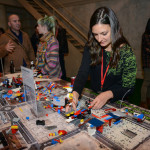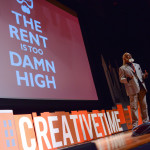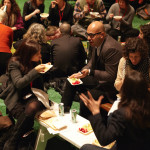The weekend before last, the annual Creative Time Summit brought individuals with various relationships to social practice art to New York for a series of presentations and conversations at the NYU Skirball Center. The theme of this year’s Summit, Art, Place & Dislocation in the 21st Century City, located the Summit within the context of some of the biggest debates in the field, particularly given many governments’ aims of using culture as a tool in city-building and the policies that have arisen around these aims. In his introduction to the Summit, Creative Time’s chief curator, Nato Thompson, addressed this context, stating, "The 2013 Creative Time Summit sets its sights on the fact that culture, for good or bad, is an active ingredient in the construction and shaping of the contemporary city." Under the umbrella of this theme, Summit participants grappled with art’s relationship to the big issues that permeate discussions of contemporary cities, particularly placemaking, urban development, and gentrification.
One of the most striking elements of the Summit was the diversity of professional roles represented onstage. Presenters included not only those who define themselves primarily as artists, but also urban planners, mayors, community organizers, researchers, activists, writers, and others invested in culture as it relates to place. Furthermore, the projects and interventions discussed highlighted the ever-growing scope of social practice art, encompassing everything from urban farming in Chicago to protests in Turkey. While the Summit illustrated the field’s continuing search for a stronger identity and deeper theoretical grounding, multiple participants remarked that people across seemingly disparate professions were starting to speak the same language. For example, comparing Laurie Jo Reynolds’ work with Tamms Year Ten, which succeeded in getting a notorious supermax prison in Illinois closed through "legislative art," or efforts such as Mayor John Fetterman’s placemaking work in post-industrial Braddock, Pennsylvania, blurs the boundaries between art, legislation, and political action. The Summit continually presented similar points of confluence and shared language.
While the Summit certainly involved participants from a variety of professional backgrounds, there was much reflection on its lack of racial and socioeconomic diversity throughout the weekend. Although Creative Time promoted increased access to the Summit through its livestream and pay-what-you-can options, the room remained heavily populated by those within more privileged art circles. One of the most poignant moments came when Project Row Houses’ Rick Lowe asked, "Is social practice gentrifying community arts?" The issue of gentrification, and artists’ role in the phenomenon, loomed large for the duration of the Summit, and multiple presenters emphasized that while placemaking can have good intentions, placemakers should consider their own arrogance and engage deeply with people rather than places, opening up the ability to create and shape place to those outside of current power and privilege structures. Lucy Lippard, who drew loud cheers from the audience, quoted the mantra, "nothing about us, without us, is for us," highlighting the need for this shift in thinking.
Overall, the Summit served as a venue for conversation and inspiration across a large range of practices, projects, and approaches. While it presented no clear answers to the big questions posed in these conversations, it provided an expanded base of ideas and ideologies for participants to draw from going forward. Much of the discussion seemed highly relevant to New England, where many cities are engaged in a post-industrial search for vibrancy and have seen culture as one tool in this process; the Summit highlighted the need for deep reflection on artists’ roles and for real community engagement and conversation as part of this activity. Throughout the weekend, participants were eager to exchange ideas and thoughts on these topics, making the benefits of talking across disciplines and practices apparent. The challenge will be applying this mindset to work beyond the Summit and, most crucially, expanding access to these conversations. If this challenge can be met, the current relationship between culture and city-building presents an opportunity for nuanced conversation and action.
- Photograph by Casey Kelbaugh, Courtesy Creative Time.
- Photograph by Casey Kelbaugh, Courtesy Creative Time.
- Photograph by Guillermo Cano Perez, Courtesy Creative Time.
- Photograph by Christos Katsiaouni, Courtesy Creative Time.










